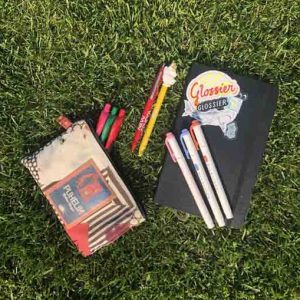How to pretend you’re organized
A stressed student’s guide to bullet journaling
By Robyn Welsh and Andi Endruhn, Publishing Editor and Layout Editor

Bullet journaling is based on the user’s creativity, don’t be afraid to make it personal. Photo by Andi Endruhn
There’s an elusive species of student out there in the world, who shows up to class looking like they didn’t just roll out of bed, they have snacks abundant, and they hand in assignments on time. There’s a mysterious aura around them resembling something like calm. They carry a small talisman, a little worn journal. Is this the secret to their success?
Alright, so maybe they still look a little dishevelled, sleep deprived and the “snacks” might be a single crushed Nature Valley bar from the bottom of their bag. That little book though? That’s a bullet journal and it’s all that stands between them and the runaway train crash that’s university life. It’s the lynchpin that’s keeping these superhuman students from collapsing into disorganized chaos like the rest of us mere mortals.
Bullet journaling combines creativity and practicality, giving full organizational power to the creator. The absolute customization of bullet journaling has helped it rocket to the forefront of organizational advice. Incorporating a to-do list, diary, notebook, sketchbook, and more, the method developed by New York designer, Ryder Carroll has opened the dull world of agendas into a more creative and intuitive age.
Starting with an empty (blank, dotted, grid, or lined—it is up to the user) notebook, the idea is to craft an organizational plan that works for you, based on your needs and requirements. While there are some popular conventions that are widely used, each bullet jounal unique to the owner’s lifestyle.
So buckle up stationary and organization nerds, bullet journaling may be just what you’ve been looking for all your life.
Start with the basics
Blank pages, let alone notebooks, can be daunting. So start simple. Some journals, like the Leuchtturm 1917 brand, have the first few pages dedicated to a table of contents. You won’t get this in a Moleskine or many other popular journal brands, but if you leave a few pages blank at the front, you can fill in your own table of contents as you go. This is recommended for easy reference, but if you find it going unused, try omitting it the next time you start a book.
Page layouts are called ‘spreads’ and many of the most popular spreads are designed to help you remember dates and your to-do lists. These can be transformed or reshaped to keep track of whatever you want, or eliminated all together!
Many bullet journalers like to create pages to introduce the coming month, and it can be a great way to start. You can keep it simple with just the month name, add monthly goals you’d like to achieve, or add interest with stickers and drawings. This page or spread can be simple and to the point, or an artistic masterpiece.
Monthly spreads, which often feature a calendar and important dates for the month, are a great way to see a large chunk of your life in front of you.
Weekly spreads help your bullet journal act similarly to an agenda. Here you can write daily to-do lists, schedule meetings and organize your week at a glance.
These spreads can be utilitarian, a tour de force of your artistic ability, or none of the above! If you’d like it to be, your bullet journal can be a place to jot down thoughts and journal.
Trial and error is everything
It can be daunting to begin when you look up images of seasoned bullet journalers’ pages and everything is masterfully designed. Realistically, you’re going to make mistakes in your bullet journal,and not every page is going to look like a work of art. You’ll miss a letter or draw a crooked line and you’ll just have to live with it.
While it can be extremely fun to design beautiful calendars, charts and lists, it is very likely that it won’t be possible to keep up with your aesthetic goals for the whole book. The beautiful thing is, you can decide how much you want to focus on design and creativity. Don’t let yourself be scared of making mistakes, it’s a part of the process!
The possibilities are endless
Try designing different pages for yourself. If you’re a film buff you could create a spread to track the titles of movies you’ve watched over the year. Want to keep track of when you feel confident or cute? Try capturing that feeling by drawing a caricature of yourself in whatever you’re wearing that day, or simply creating a space to write down moments that leave you feeling great.
Trying to break or create habits? A habit tracker can be a great way to keep track of your progress. Colouring in boxes and being able to see progress in front of you helps with motivation.
There is no limit to what you can do with your bullet journal. It is completely customizable, so let your creativity and personality shine through and make your journal your own!




